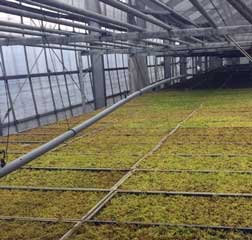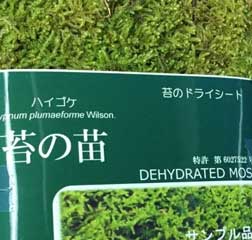EN_ FOR A GREEN ARCHITECTURE AND RESTORATIVE ECOLOGY:
A scalable growing system to supply green roofs and living walls with moss and lichen cover

EN_ Mosses and lichens have many beneficial qualities that make them suitable for horticultural applications; however they are under-utilized in Canadian landscape architecture. Mosses and lichens lack extensive roots systems, and therefore do not require much soil. This means they could be applied to rooftops with little to no structural enhancement. The combination of small shoot-size with a colonial, mat-forming growth habit makes them amenable to applications ranging from small-scale, indoor greenery to large-scale outdoor rehabilitation projects. Adding mosses and lichens to the suite of green architecture species expands the market to include residential, as well as commercial structures, thereby increasing access to green roof esthetics and ecological services for all Canadians.
The “Moss Machine” growth chamber, is a multi-layered, low-cost rapid cultivation of mat-forming mosses and lichens over layers of organic fabric, resulting in blankets of live, desiccation-resistant vegetation. The space-saving requirements of advanced stacked-tray hothouse production systems will also be employed. We intend to take advantage of recent advances in small-scale LED grow-lighting systems to limit the cost and stressful temperature increases associated with halogen or fluorescent lighting in growth carts.
The results of the project will be (1) a prototype growth chamber (the Moss Machine) that can produce field-ready mats of moss and lichen species, (2) an ongoing field experiment to evaluate the persistence and rigour of moss mats on residential rooftops, and (3) a new resource for landscape architects to use in numerous applications.
UPDATES_ MISES À JOUR
2018.12_ Update: Drs. Haughian and Lundholm has completed their work and an article on their findings will be printed within the next few months, when published a link will be provided on the lacf.ca website. The Moss Machine study has demonstrated that mosses can be grown with ease in an indoor setting. The mosses from this first trial are now being field-tested on a green-roof, with survival and growth contrasted against wild-harvested material over several months. We look forward to additional testing of new watering regimens, lighting designs, and species combinations as we develop this valuable and under-utilized resource.
2019.07.12_ Final Report_ Moss for Article
2024_ Read a recent article on the research: Mosses for minimalist green roofs: a preliminary study of the effects of rooftop exposure, species selection, and lab-grown vs. wild-harvested propagule sources
FR_ UNE MACHINE À MOUSSE POUR UNE ARCHITECTURE VERTE ET LA RESTAURATION ÉCOLOGIQUE :
un système de culture évolutif pour fournir des toits verts et des murs végétalisés avec des couvertures de mousse et de lichen

Les mousses et les lichens ont de nombreuses qualités bénéfiques qui les rendent adaptés aux applications horticoles. Toutefois, ils sont sous-utilisés dans l’architecture de paysage canadienne. Les mousses et les lichens ont un système radiculaire peu développé et ne nécessitent donc pas beaucoup de terre. Cela signifie qu’ils pourraient être plantés sur les toits avec peu ou pas de renforcement structurel. La combinaison de petites pousses ayant une croissance coloniale qui forme des tapis, les rendent aptes à des applications allant de la petite verdure intérieure à des projets extérieurs de réhabilitation à grande échelle. L’ajout de mousses et de lichens aux espèces utilisées en architecture verte élargit le marché pour inclure des structures résidentielles et commerciales, augmentant ainsi l’accès à l’esthétique des toits verts et aux services écologiques pour tous les Canadiens.
La chambre de croissance « Machine à mousse » est une culture rapide multicouche et peu coûteuse de mousses et de lichens formant des tapis sur des couches de tissu écologique, fournissant ainsi des couvertures de végétation vivante résistant à la dessiccation. Nous tiendrons également compte des exigences en matière de gain de place des systèmes de production de serres à plateau empilé. Nous avons l’intention de profiter des avancées récentes qui ont été faites dans les systèmes d’éclairage à DEL de petite échelle pour limiter le coût et les augmentations de température stressantes associés à l’éclairage halogène ou fluorescent dans les chariots de croissance.
Les résultats du projet seront (1) un prototype de chambre de croissance (la Machine à mousse) qui peut produire des tapis de mousse et de lichen prêts pour le terrain (2) une expérience sur le terrain en cours pour évaluer la persistance et la rigueur des tapis de mousse pour les toits résidentiels (3) une nouvelle ressource que les architectes paysagistes peuvent utiliser dans de nombreuses situations.
